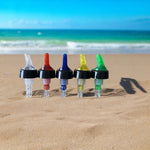DEET, which stands for N,N-Diethyl-meta-toluamide, is primarily used as an active ingredient in insect repellents. It's highly effective in repelling various types of insects, including mosquitoes, ticks, fleas, chiggers, leeches, and many biting flies.
DEET works by interfering with the receptors on the insects' antennae and mouth-parts that are used to detect carbon dioxide and lactic acid, which are emitted by humans and are attractive to insects.
This makes the person using DEET less detectable to these insects, significantly reducing the likelihood of being bitten.
DEET has been widely used for many years and is known for its effectiveness and durability, providing long-lasting protection against insect bites.
What are the adverse reactions to DEET?
DEET, while generally considered safe when used according to the instructions, can cause adverse reactions in some individuals.
The severity and type of reactions can vary based on concentration, frequency of use, and individual sensitivity. Here are some of the potential adverse reactions:
Skin Reactions
Some people may experience skin irritation, redness, rashes, or a burning sensation when DEET is applied. This is more common with higher concentrations of DEET or with prolonged or frequent use.
Neurological Effects
Although rare, there have been reports of neurological effects, particularly with heavy or prolonged use of high-concentration DEET products. Symptoms can include headaches, tremors, seizures, or, in extreme cases, encephalopathy (a brain disease).
Eye Irritation
DEET can cause irritation if it gets into the eyes, leading to pain, redness, or a burning sensation.
Respiratory Effects
Inhaling DEET can lead to respiratory discomfort, coughing, or shortness of breath, especially in individuals with pre-existing respiratory conditions.
Allergic Reactions
Some individuals may have an allergic reaction to DEET, which could manifest as a rash, swelling, or difficulty breathing.
Ingestion Risks
Accidental ingestion of DEET can be harmful and lead to symptoms like nausea, vomiting, and, in severe cases, seizures or hypotension.It's important to use DEET-containing products as directed, typically applying them on exposed skin and clothing, avoiding overuse, and washing treated skin after returning indoors.
For children and sensitive individuals, lower concentrations are recommended, and it's advisable to consult a healthcare provider before use if there are any concerns.
Is DEET safe for kids?
DEET is generally considered safe for children, but with specific precautions and guidelines. The American Academy of Pediatrics (AAP) and other health authorities provide recommendations for its safe use in children:
Age Restrictions
DEET is not recommended for use on infants younger than 2 months old. For babies under this age, other protective measures like mosquito netting over strollers and baby carriers are advised.
Concentration Levels
For children, products containing 10% to 30% DEET are often recommended. These concentrations provide sufficient protection while minimizing potential risks. Higher concentrations don't offer better protection but do provide longer-lasting protection. However, for children, the duration of effectiveness should be balanced with safety.
Application Guidelines
When applying DEET to children, adults should apply it. Avoid applying it to children's hands, around their eyes, or on any cuts, wounds, or irritated skin.
Best applied to clothing.
Frequency of Use
Avoid repeated applications in a day, particularly if there's no significant risk of insect bites in the current environment.
Avoiding Inhalation and Ingestion
Ensure that children don't breathe in the spray or get it in their mouths. Spray formulations should be used in open areas to avoid inhalation.
Post-Use Washing
Wash treated skin with soap and water , always wash thoroughly at end of day and especially before meals.
Watch for Reactions
Parents and caregivers should be vigilant for any adverse reactions, such as skin irritation or unusual symptoms, and seek medical advice if concerns arise.
By following these guidelines, DEET can be used safely and effectively to protect children from insect bites. If there are any concerns or if a child has sensitive skin or other health issues, it's advisable to consult a healthcare professional before using DEET-based products.
Is DEET harmful to the environment and wildlife?
DEET can have adverse effects on the environment and wildlife. While its primary use as an insect repellent for humans is generally considered safe, its ecological impact raises concerns. These include:
Aquatic Toxicity
DEET is toxic to some aquatic organisms, including fish and invertebrates. When it enters water bodies through wastewater or runoff, it can harm aquatic life. DEET has been detected in water sources such as rivers and streams, potentially affecting the ecosystems there.
Soil and Plant Impact
DEET can also affect soil and plants. It has the potential to accumulate in the soil, potentially affecting microorganisms and plants. Its impact on various plant species can vary, but it may inhibit growth or cause other changes.
Wildlife
While there's limited direct evidence of DEET's impact on wildlife, given its toxicity to certain aquatic species, it's plausible that it could have detrimental effects if wildlife is exposed to high concentrations or through contaminated water or food sources.
Persistence and Bioaccumulation
DEET is not highly persistent in the environment, but it doesn't break down instantly either. There is some concern about its potential to bioaccumulate, although current evidence suggests that it doesn't significantly accumulate in animal tissues.
Interaction with Other Chemicals
The environmental impact of DEET can also be influenced by its interaction with other chemicals. In combination with other pollutants, it might contribute to more complex and potentially harmful environmental effects.
To mitigate these risks, it is important to use DEET responsibly. This includes avoiding excessive use and not applying it near water bodies. Additionally, further research and monitoring are needed to fully understand and manage the environmental impacts of DEET.















